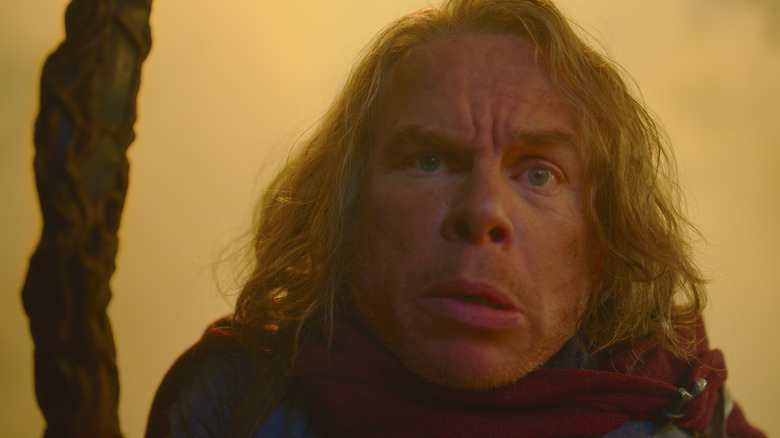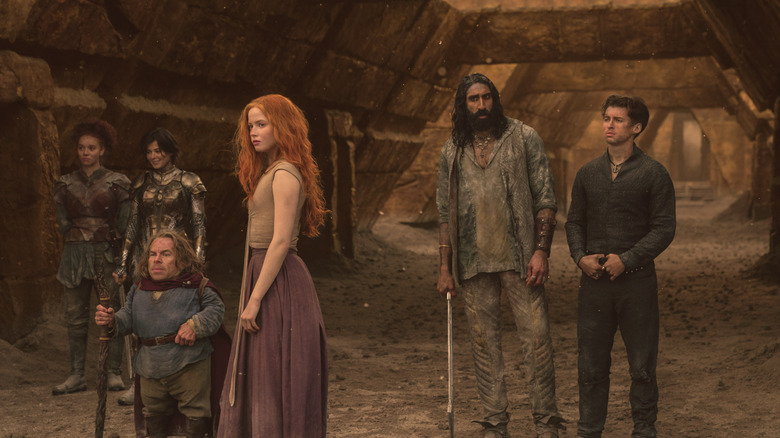Disney Spent $100 Million Making Willow, Then Threw It In The Bin
"When I got my job ... I saw a world where technology has enabled storytelling to proliferate much more and there is much more consumer choice," enthused Disney CEO Bob Iger in a talk at the Wharton School in November 2019, on the eve of Disney+ launching worldwide. "Don't let the economy get in the way of making something great, don't let time get in the way of making something great," he continued. "Don't be limited by the amount of time it takes or the amount of money. Greatness is a necessity and an imperative."
This go-big-or-go-home attitude was emblematic of the content wars, as Disney, Warner Bros., Apple, and others raced to launch their own streaming services and line up a shiny collection of prestige original content for them, emboldened by the big spending of Netflix and Amazon. A pitch on the set of "Solo: A Star Wars Story" a few years earlier had become the seed for one such slice of content: "Willow," an episodic sequel to the 1988 film of the same name that would further capitalize on Disney's 2012 acquisition of Lucasfilm. Now, thanks to financial statements filed by Disney and parsed by Forbes' Caroline Reid, we know how much Disney spent on the production of "Willow" in the UK: $105.9 million. That's more than $13 million per episode.
"Willow" premiered on November 30, 2022. In May 2023, less than six months later, it was removed, along with dozens of other shows and movies. It's not available to watch on any other streaming service, and there are no plans for a physical release on Blu-ray or DVD. Currently, it's impossible to legally watch "Willow" anywhere. In exchange for this and the rest of the content purge, Disney was able to write off $1.5 billion in the second quarter of 2023, considerably reducing its tax bill. So that's nice.
Someone who is good at the economy please help me budget this
"We turned what had become a producer's medium back into a director's medium," Iger boasted in 2019, "where the stories we're telling typically emanate from directors' hearts and minds." And if that $105.9 million TV show that you greenlit exclusively for a $7.99 per month streaming service somehow fails to turn a profit? "You have to figure out how to process that; you don't want to wallow in failure. You have to say this is a business and move on."
Not being as well-versed in business stuff as Iger and his fellow Hollywood CEOs, I have to admit I scratched my head a little when Netflix shelled out $200 million for the Russo brothers' spy film "The Gray Man," and when Amazon later greenlit the Russo brothers' $300 million spy series "Citadel" (really, the Russos have done very well out of this) shortly after spending $715 million — or the equivalent of 5.1 million annual Prime Video subscriptions — on a lavish "Lord of the Rings" TV show.
From a layman's perspective, it was difficult to see how any of these shows or movies were ever going to turn a profit without the ad revenue that comes with traditional TV or, in the case of movies, a theatrical run at the box office. But the studios seemed confident in what they were doing, and when the COVID-19 pandemic arrived, streaming suddenly seemed like a very smart investment.
Three years later, though, it looks like the layman's perspective may have been the clearest view. As of Disney's latest earnings report (via the New York Times), Disney's streaming losses since 2019 add up to $11 billion. In 2022, Netflix was the only streaming service that turned a profit. Now, studios are pivoting from "go big or go home" to a new business strategy: go home, and then burn down your home for tax purposes.

